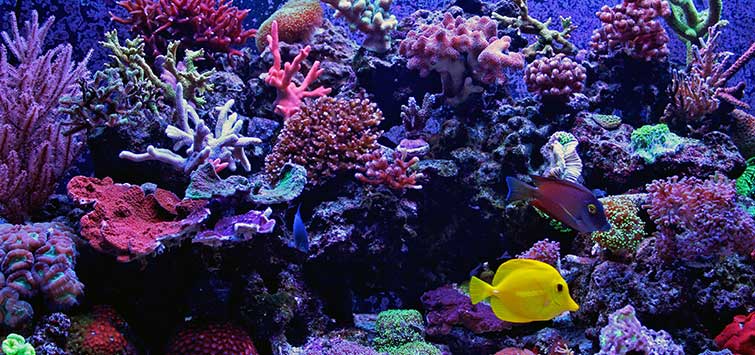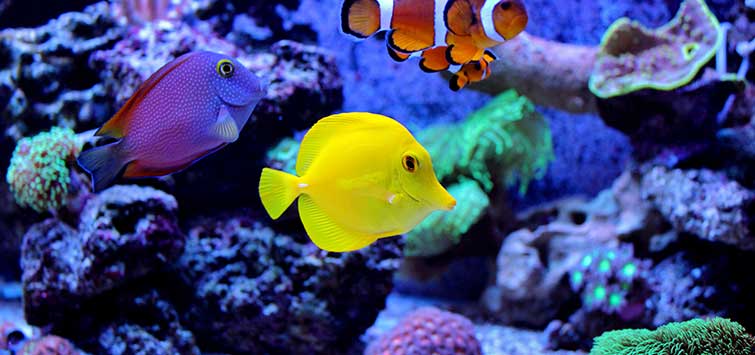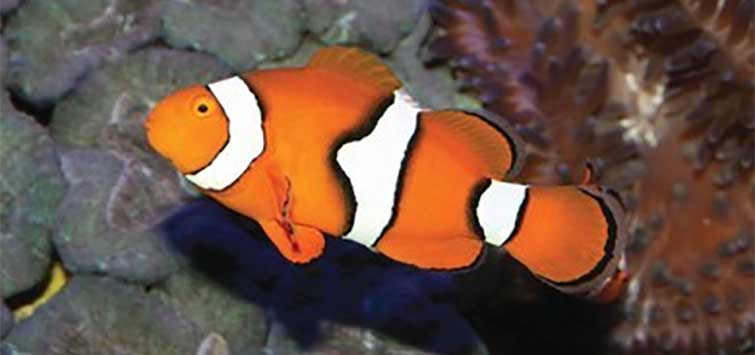The Salt Creep: Key Considerations for the Aspiring Reefkeeper
Author: Jeff Kurtz
There are as many different approaches to keeping a reef aquarium as there are reefkeepers out there. Ranging from low-tech to high-tech and everything in between, no two reef systems are completely identical—and what works for one hobbyist may or may not work for another. Hence, one aquarist may strongly advocate one approach while another may say, “Are you crazy? I tried it that way and failed miserably. My way is the way. You really should do it my way.”
For aspiring reefkeepers, these conflicting signals can lead to a lot of confusion and may even discourage them from venturing further into a very rewarding aspect of our hobby. To those who might otherwise shy away from reefkeeping due to the overwhelming number of decisions to be made, I offer these words of encouragement: take heart! Though no two aquarists approach reefkeeping in precisely the same way, there are certain characteristics that most successful reef systems—and reef aquarists—share in common. If you keep in mind the following key considerations when setting up your system, your odds of success will increase significantly. These factors apply whether you’re talking about a 500-gallon system with all the bells and whistles or a 2-gallon desktop nano reef.
Choose a Budget-Friendly System
Setting up a reef system is a bit like buying a new house. Beyond the monthly mortgage payment, you have to factor in the expense of ongoing upkeep and maintenance. Otherwise you won’t be able to afford to fix that leaky roof or replace that malfunctioning furnace, and your dream home will soon feel more like a debtor’s prison. The same applies to a reef tank.
As a general rule, the bigger the system the greater the expense of upkeep. Though bigger is considered better when it comes to the stability of water parameters, larger systems need more powerful lights and a larger number of them. They also use up a lot more sea salt, require more live rock, consume more additives, demand greater filtration and protein-skimming capacity, and, of course, accommodate more livestock.
Make sure you’ve got the budget to maintain your system—whatever size it may be—for the long haul so cash-flow shortfalls won’t force you to take shortcuts or postpone maintenance to the detriment of your livestock.
Start with the Purest Possible Source Water
Success with a reef system is largely about eliminating uncontrollable variables, and for many hobbyists one of the biggest unknowns is the precise makeup of their tap water. Some municipalities issue annual reports on tap-water quality, so citizens have a pretty good idea what’s in there; but many cities don’t issue such reports. Tap water may contain a wide variety of contaminants that, while safe for people to drink, are potentially harmful or fatal to reef invertebrates and/or will contribute to the proliferation of undesirable algae. These include contaminants such as chlorine, chloramine, nitrate, phosphate, lead, copper, and other impurities.
While you may be able to get away with using straight tap water in the short term, these impurities can build up over time, leading to big headaches down the road. The best way to eliminate most source-water contaminants is to process your tap water through a reverse osmosis (RO) or reverse osmosis/de-ionizing (RO/DI) system before adding it to the tank. And RO or RO/DI water should be used every time you mix up a batch of salt water or top off fresh water lost to evaporation.
Match the Lighting to the Livestock
As any aspiring reefkeeper quickly discovers, lighting of the proper intensity and spectral characteristics is critical for maintaining photosynthetic corals and other sessile invertebrates. Your lighting will also be one of your biggest expenses (if not the biggest expense) when setting up a new reef system, so you want to get it right the first time.
But with an absolutely staggering number of lighting options and combinations on the market, this is one of those areas that can really make a beginner’s head spin with questions. Is it better to go with fluorescent tubes or metal halides? What about a combination of the two? What do all those acronyms, like NO, HO, and VHO, mean? Who’s this “Kelvin” guy, and what does his temperature have to do with my aquarium lights?
There are many excellent books and other sources out there that will help demystify reef aquarium lighting, so I won’t attempt to answer all of these questions within the confines of this article. However, I will emphasize that it’s critical to match your lighting to the needs of the invertebrates you intend to keep.
For example, if you want to keep mushroom polyps, which prefer more subdued fluorescent lighting, you wouldn’t want to subject them to the merciless glare of high-wattage metal halide lamps. Under those circumstances the mushroom polyps will very quickly wither and perish. On the other hand, light-loving small-polyp stony corals, such as the various Acropora species, will generally do quite well under metal halides. My best advice in this area is to plan your livestock acquisitions so that you’ll have specimens that have been demonstrated to thrive under lighting of a similar intensity, and then choose fixtures and lamps that will provide that level of intensity. And remember, more powerful lighting isn’t always the better option!
Lighten the Bioload
The advice that applies to any aquarium—to keep the bioload at a sustainable level—is diligently heeded by successful reefkeepers. In our efforts to recreate a bustling slice of coral reef in our aquariums, it’s tempting to get carried away with the addition of specimens, especially fish. But overstocking results in excessive dissolved nutrients, which is not only directly harmful to corals, but also taxes the biological filtration capacity of the system and often leads to unsightly and unmanageable algae growth.
More experienced reefkeepers stock lightly, allowing room for each coral specimen to reach its full growth potential without encroaching too much on its neighbors. Fish acquisitions are limited to a small number of compatible reef-friendly species to avoid overburdening the biofilter and to prevent the invertebrates from being constantly nibbled and nipped at.
Choose Compatible Corals
Anyone who has any amount of aquarium-keeping experience is at least somewhat familiar with the concept of specimen compatibility as it applies to fish. But to be a successful reefkeeper one must also develop a reasonable understanding of compatibility as it applies to sessile invertebrates. Some, including many Sarcophyton leather corals, wage “chemical warfare,” releasing toxic compounds into the water that either kill or stunt the growth of potential competitors. Others, including the various Euphylliaspecies, nettle their neighbors with long “sweeper tentacles.” Still others use their capacity for rapid growth to overgrow and shade out their neighbors, thereby depriving them of light. And that’s just a sampling of the devious means corals employ to protect their position on a desirable patch of reef.
Having at least a working knowledge of the defense mechanisms of corals will help to ensure that the aspiring reefkeeper selects compatible specimens and places them appropriately (relative to other specimens) in the aquarium. For some excellent background in this area, I would strongly recommend reading Eric Borneman’s Aquarium Corals: Selection, Husbandry, and Natural History (TFH/Microcosm Professional Series, 2001).
Make the Most of Water Movement
When it comes to water movement, coral reefs are extremely dynamic places. Depending on where they occur on natural reefs, corals may be exposed to calm waters, gentle flow, moderate turbulence, powerful surge, or crashing surf. Therefore, just as they do in nature, different coral species require different levels of water movement in the aquarium. Going back to our mushroom polyp/Acroporaexample, the mushrooms favor more gentle conditions, while Acropora corals prefer vigorous water movement.
Appropriate water movement serves several important functions. For one, it keeps detritus in suspension so it can be removed from the system via mechanical filtration, keeping it from settling on and smothering corals. Water movement flowing over corals also helps them get rid of wastes and, for some species (e.g., leather corals), helps to facilitate the regenerative sloughing of tissue.
The best form of water movement is turbulent rather than linear. In other words, you don’t want to blast a specimen from one direction with a continuous flow of water. Instead, water should flow over and around it from alternating directions or from several directions at once. The desired turbulence can be achieved by strategically directing several powerheads and return hoses so their flows deflect off of each other or bank off the aquarium glass. Powerheads can also be placed on a wave-maker timer, so they alternate on and off, creating a somewhat natural wave-like effect. Aquarists who enjoy tinkering might also enjoy experimenting with various do-it-yourself surge devices.
Make an Ally of Water Changes
Just as in any aspect of aquarium keeping, routine partial water changes are a must for reefkeepers. I’m of the belief that no amount of gadgetry or equipment can take the place of the routine partial water change. Consider it the “great equalizer.” Staying on top of those water changes—at least 20 percent of your aquarium’s volume per month—is the best way to maintain balanced water parameters and to prevent dissolved nutrients from accumulating to deleterious levels. Provided you’re starting with pure source water (and, therefore, are not unwittingly introducing nitrate, phosphate, or other contaminants), regular water changes will be your greatest ally.
Whatever size reef tank you’ve set your sites on and regardless of how elaborate or equipment-intensive your system will be, keeping these key considerations in mind will be your starting point on the road to success in reefkeeping. As you progress in the hobby, you’ll hear widely divergent arguments over which type of system is best, and you’ll often be tempted to change course in response to current trends. Always keep in mind, however, that while equipment fads may come and go, the fundamentals of good aquarium husbandry never really change.

.png?h=595&iar=0&w=2781&hash=5FD5E69473BCC22199FBFA2FB71B6033)



